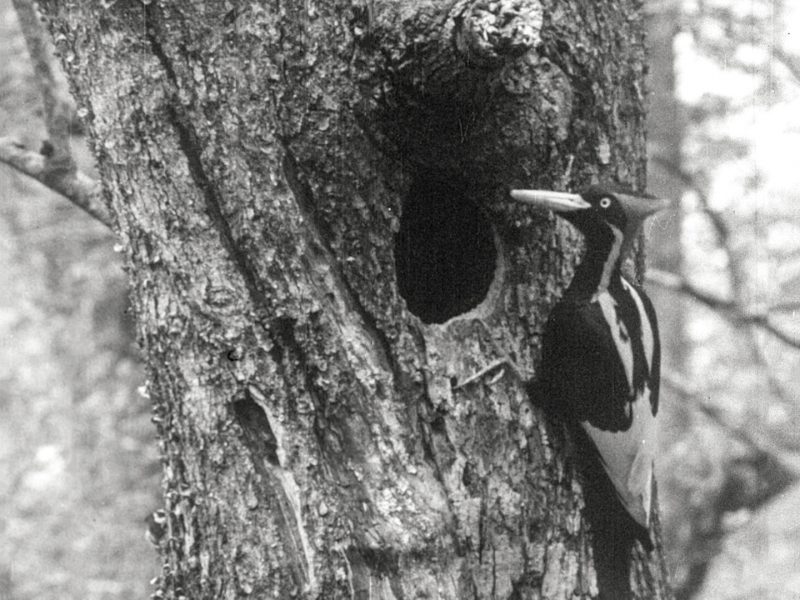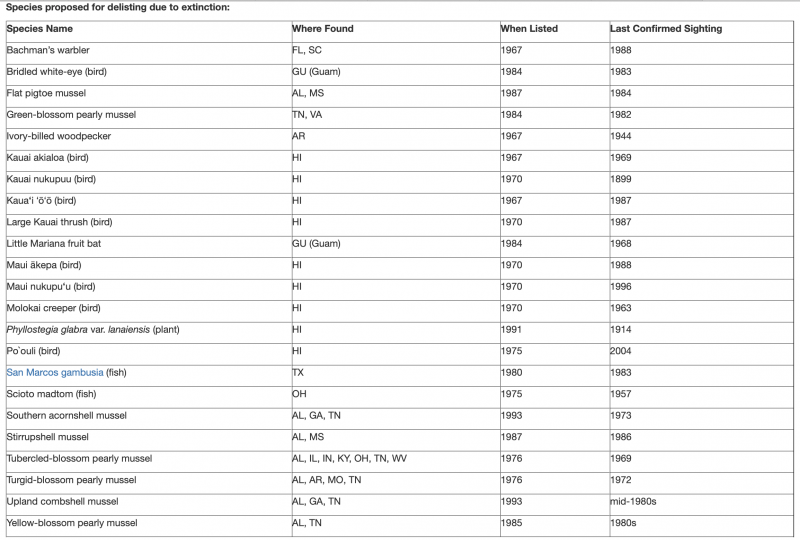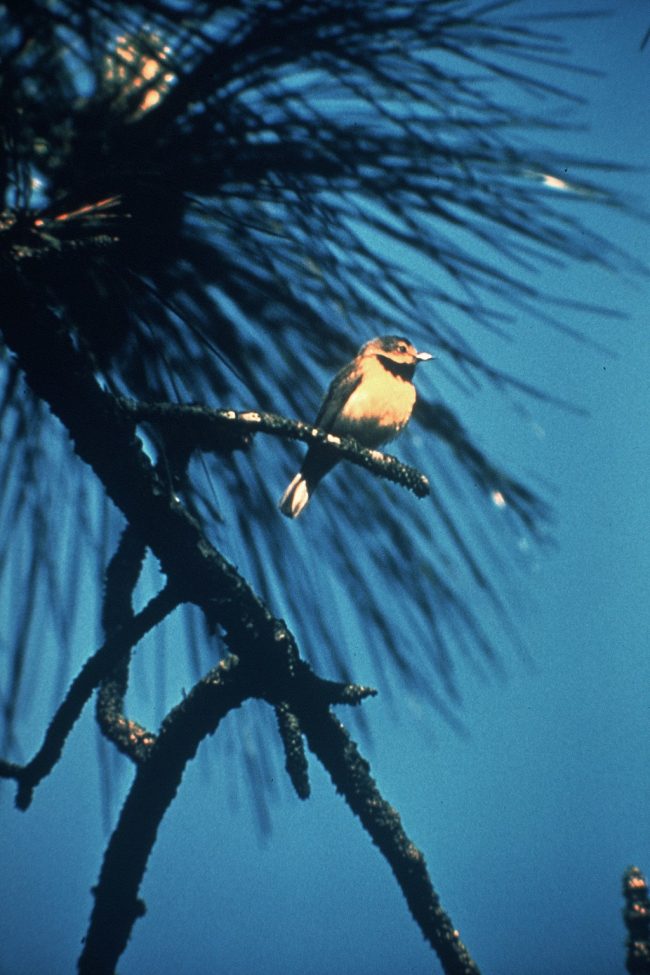
23 species proposed for delisting
The U.S. Fish and Wildlife Service (USFW) said on September 29, 2021 that it proposes delisting 23 species from Endangered Species Act due to extinction. This includes the beloved ivory-billed woodpecker, Bachman’s warbler, two species of freshwater fishes, eight species of Southeastern freshwater mussels and 11 species from Hawaii and the Pacific Islands. USFW said:
Based on rigorous reviews of the best available science for each of these species, the Service has determined these species are extinct, and thus no longer require listing under the ESA.
USFW Secretary Deb Haaland of USFW commented:
With climate change and natural area loss pushing more and more species to the brink, now is the time to lift up proactive, collaborative, and innovative efforts to save America’s wildlife.
On the other hand, the release from USFW also said:
While protections were provided too late for these 23 species, the ESA has been successful at preventing the extinction of more than 99% of species listed. In total, 54 species have been delisted from the ESA due to recovery, and another 56 species have been downlisted from endangered to threatened. The Service’s current workplan includes planned actions that encompass 60 species for potential downlisting or delisting due to successful recovery efforts. Additionally, numerous species have avoided ESA listing thanks to the collaborative efforts of federal agencies, states, Tribes and private landowners, with the ESA serving as a catalyst for conservation efforts that help protect imperiled species and their habitat.
So the news is sad, but not all bad. Humans can and do play a stewardship role.

Detail on the species that were lost
Ivory-billed woodpecker – Once America’s largest woodpecker, it was listed in 1967 as endangered under the precursor to the ESA, the Endangered Species Preservation Act (ESPA). The last commonly agreed upon sighting of the ivory-billed woodpecker was in April 1944 on the Singer Tract in the Tensas River region of northeast Louisiana. Despite decades of extensive survey efforts throughout the southeastern U.S. and Cuba, it has not been relocated. Primary threats leading to its extinction were the loss of mature forest habitat and collection.
Bachman’s warbler – As early as 1953, Bachman’s warbler was one of the rarest songbirds in North America. When first listed in 1967 as an endangered species under the Endangered Species Preservation Act, the bird had not been seen in the U.S. since 1962. Last documented in Cuba in 1981, there have been no verifiable sightings in that country since then. The loss of mature forest habitat and widespread collection are the primary reasons for its extinction.
Eight species of freshwater mussels – Reliant on healthy streams and rivers with clean, reliable water, freshwater mussels are some of the most imperiled species in the U.S., home to more than half of the world’s species of freshwater mussels. Mussels proposed for delisting due to extinction are all located in the Southeast, America’s biodiversity hot spot for freshwater mussels. They are the: flat pigtoe (Mississippi), southern acornshell (Alabama, Georgia, Tennessee), stirrupshell (Alabama), upland combshell, (Georgia, Alabama, Tennessee), green-blossom pearly (Tennessee, Virginia), turgid-blossom pearly mussel (Tennessee, Alabama, Arkansas), yellow-blossom pearly mussel (Tennessee, Alabama) and the tubercled-blossom pearly mussel(Alabama, Illinois, Indiana, Kentucky, Tennessee, West Virginia, southern Ontario, Canada).
Hawai’i and the Pacific Islands – Eleven species from Hawai?i and Guam are being proposed for delisting due to extinction, many of which had striking characteristics, such as the long curved beaks of the Kauai akialoa and nukupu?u, the haunting call of the Kauai `o`o, and the brilliant colors of the Maui akepa and Molokai creeper. Species endemic to islands face a heightened risk of extinction due to their isolation and small geographic ranges. Hawai?i and the Pacific Islands are home to more than 650 species of plants and animals listed under the ESA. This is more than any other state, and most of these species are found nowhere else in the world.
San Marcos gambusia – Listed in 1980, this freshwater fish was found in the slow-flowing section of the San Marcos River in Texas. The San Marcos gambusia had a limited historic range of occurrence and has not been found in the wild since 1983. Primary reasons for its extinction include habitat alteration due to groundwater depletion, reduced spring flows, bottom plowing and reduced aquatic vegetation, as well as hybridization with other species of gambusia.
Scioto madtom – Listed as endangered in 1975, the Scioto madtom was a fish species found in a small section of the Big Darby Creek, a tributary of the Scioto River, in Ohio. The Scioto madtom was known to hide during the daylight hours under rocks or in vegetation and emerge after dark to forage along the bottom of the stream. Only 18 individuals of the madtom were ever collected with the last confirmed sighting in 1957. The exact cause of the Scioto madtom’s decline is unknown, but was likely due to modification of its habitat from siltation, industrial discharge into waterways and agricultural runoff.

You can comment
USFW also said:
The Service seeks information, data, and comments from the public regarding this proposal to remove these 23 species from the ESA and declare them extinct. The proposed rule will be available in the Federal Register Reading Room on September 29, 2021 at https://www.federalregister.gov/public-inspection using the link found under the Fish and Wildlife Service Endangered and Threatened Wildlife and Plants section. This will be publishing in the Federal Register on September 30, 2021.
We will accept comments received or postmarked on or before December 29, 2021. Comments submitted electronically using the Federal eRulemaking Portal must be received by 11:59 p.m. Eastern Time on the closing date.
Check out the poignant video of the Ivory-billed Woodpecker, below. Strange to think the hopeful birds in this video were headed for extinction.
Bottom line: U.S. Fish and Wildlife proposed to delist 23 species on September 29, 2021, due to extinction.
See more video and photos of the Ivory-billed Woodpecker, and hear its cry
The post 23 species proposed for delisting, now extinct first appeared on EarthSky.
from EarthSky https://ift.tt/3upAtUP

23 species proposed for delisting
The U.S. Fish and Wildlife Service (USFW) said on September 29, 2021 that it proposes delisting 23 species from Endangered Species Act due to extinction. This includes the beloved ivory-billed woodpecker, Bachman’s warbler, two species of freshwater fishes, eight species of Southeastern freshwater mussels and 11 species from Hawaii and the Pacific Islands. USFW said:
Based on rigorous reviews of the best available science for each of these species, the Service has determined these species are extinct, and thus no longer require listing under the ESA.
USFW Secretary Deb Haaland of USFW commented:
With climate change and natural area loss pushing more and more species to the brink, now is the time to lift up proactive, collaborative, and innovative efforts to save America’s wildlife.
On the other hand, the release from USFW also said:
While protections were provided too late for these 23 species, the ESA has been successful at preventing the extinction of more than 99% of species listed. In total, 54 species have been delisted from the ESA due to recovery, and another 56 species have been downlisted from endangered to threatened. The Service’s current workplan includes planned actions that encompass 60 species for potential downlisting or delisting due to successful recovery efforts. Additionally, numerous species have avoided ESA listing thanks to the collaborative efforts of federal agencies, states, Tribes and private landowners, with the ESA serving as a catalyst for conservation efforts that help protect imperiled species and their habitat.
So the news is sad, but not all bad. Humans can and do play a stewardship role.

Detail on the species that were lost
Ivory-billed woodpecker – Once America’s largest woodpecker, it was listed in 1967 as endangered under the precursor to the ESA, the Endangered Species Preservation Act (ESPA). The last commonly agreed upon sighting of the ivory-billed woodpecker was in April 1944 on the Singer Tract in the Tensas River region of northeast Louisiana. Despite decades of extensive survey efforts throughout the southeastern U.S. and Cuba, it has not been relocated. Primary threats leading to its extinction were the loss of mature forest habitat and collection.
Bachman’s warbler – As early as 1953, Bachman’s warbler was one of the rarest songbirds in North America. When first listed in 1967 as an endangered species under the Endangered Species Preservation Act, the bird had not been seen in the U.S. since 1962. Last documented in Cuba in 1981, there have been no verifiable sightings in that country since then. The loss of mature forest habitat and widespread collection are the primary reasons for its extinction.
Eight species of freshwater mussels – Reliant on healthy streams and rivers with clean, reliable water, freshwater mussels are some of the most imperiled species in the U.S., home to more than half of the world’s species of freshwater mussels. Mussels proposed for delisting due to extinction are all located in the Southeast, America’s biodiversity hot spot for freshwater mussels. They are the: flat pigtoe (Mississippi), southern acornshell (Alabama, Georgia, Tennessee), stirrupshell (Alabama), upland combshell, (Georgia, Alabama, Tennessee), green-blossom pearly (Tennessee, Virginia), turgid-blossom pearly mussel (Tennessee, Alabama, Arkansas), yellow-blossom pearly mussel (Tennessee, Alabama) and the tubercled-blossom pearly mussel(Alabama, Illinois, Indiana, Kentucky, Tennessee, West Virginia, southern Ontario, Canada).
Hawai’i and the Pacific Islands – Eleven species from Hawai?i and Guam are being proposed for delisting due to extinction, many of which had striking characteristics, such as the long curved beaks of the Kauai akialoa and nukupu?u, the haunting call of the Kauai `o`o, and the brilliant colors of the Maui akepa and Molokai creeper. Species endemic to islands face a heightened risk of extinction due to their isolation and small geographic ranges. Hawai?i and the Pacific Islands are home to more than 650 species of plants and animals listed under the ESA. This is more than any other state, and most of these species are found nowhere else in the world.
San Marcos gambusia – Listed in 1980, this freshwater fish was found in the slow-flowing section of the San Marcos River in Texas. The San Marcos gambusia had a limited historic range of occurrence and has not been found in the wild since 1983. Primary reasons for its extinction include habitat alteration due to groundwater depletion, reduced spring flows, bottom plowing and reduced aquatic vegetation, as well as hybridization with other species of gambusia.
Scioto madtom – Listed as endangered in 1975, the Scioto madtom was a fish species found in a small section of the Big Darby Creek, a tributary of the Scioto River, in Ohio. The Scioto madtom was known to hide during the daylight hours under rocks or in vegetation and emerge after dark to forage along the bottom of the stream. Only 18 individuals of the madtom were ever collected with the last confirmed sighting in 1957. The exact cause of the Scioto madtom’s decline is unknown, but was likely due to modification of its habitat from siltation, industrial discharge into waterways and agricultural runoff.

You can comment
USFW also said:
The Service seeks information, data, and comments from the public regarding this proposal to remove these 23 species from the ESA and declare them extinct. The proposed rule will be available in the Federal Register Reading Room on September 29, 2021 at https://www.federalregister.gov/public-inspection using the link found under the Fish and Wildlife Service Endangered and Threatened Wildlife and Plants section. This will be publishing in the Federal Register on September 30, 2021.
We will accept comments received or postmarked on or before December 29, 2021. Comments submitted electronically using the Federal eRulemaking Portal must be received by 11:59 p.m. Eastern Time on the closing date.
Check out the poignant video of the Ivory-billed Woodpecker, below. Strange to think the hopeful birds in this video were headed for extinction.
Bottom line: U.S. Fish and Wildlife proposed to delist 23 species on September 29, 2021, due to extinction.
See more video and photos of the Ivory-billed Woodpecker, and hear its cry
The post 23 species proposed for delisting, now extinct first appeared on EarthSky.
from EarthSky https://ift.tt/3upAtUP

Aucun commentaire:
Enregistrer un commentaire